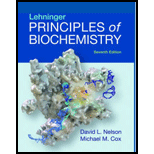
Concept explainers
(a)
To explain: Why the structure of amino-butyric acid is suitable substitution for Cys residue and under what circumstances it would not be suitable.
Introduction:
Protein is an essential bio-molecule which also serves as a building block of body. It helps in growth and development of the body. It is involved in the formation of hair, skin, muscle and connective tissue. The proteins are of four types: primary, secondary, tertiary, and quaternary.
(b)
To determine: The reasons to predict that a protein synthesized, denatured, and folded in this manner (dissolving it in 6 M guanidine HCl, and then allowed it to fold slowly by dialyzing away the guanidine against a neutral buffer) would not be active.
Introduction:
Protein is an essential bio-molecule which also serves as a building block of body. It helps in growth and development of the body. It is involved in the formation of hair, skin, muscle and connective tissue. The proteins are of four types: primary, secondary, tertiary, and quaternary.
(c)
To determine: The finding that tells about the role of disulfide bonds in native HIV protease molecule.
Introduction:
Protein is an essential bio-molecule which also serves as a building block of body. It helps in growth and development of the body. It is involved in the formation of hair, skin, muscle and connective tissue. The proteins are of four types: primary, secondary, tertiary, and quaternary.
(d)
To determine: Whether or not it is likely an outcome.
Introduction:
Protein is an essential bio-molecule which also serves as a building block of body. It helps in growth and development of the body. It is involved in the formation of hair, skin, muscle and connective tissue. The proteins are of four types: primary, secondary, tertiary, and quaternary.
(e)
To determine: The model that is proposed above that supports these data.
Introduction:
Protein is an essential bio-molecule which also serves as a building block of body. It helps in growth and development of the body. It is involved in the formation of hair, skin, muscle and connective tissue. The proteins are of four types: primary, secondary, tertiary, and quaternary.
(f)
To determine: The reason for Evans blue to inhibit both forms of the protease.
Introduction:
Protein is an essential bio-molecule which also serves as a building block of body. It helps in growth and development of the body. It is involved in the formation of hair, skin, muscle and connective tissue. The proteins are of four types: primary, secondary, tertiary, and quaternary.
(g)
To determine: Can chymotrypsin digest the D-protease.
Introduction:
Protein is an essential bio-molecule which also serves as a building block of body. It helps in growth and development of the body. It is involved in the formation of hair, skin, muscle and connective tissue. The proteins are of four types: primary, secondary, tertiary, and quaternary.
(h)
To determine: The analysis of the total synthesis from D-amino acids followed by renaturation to yield active enzyme for any enzyme.
Introduction:
Protein is an essential bio-molecule which also serves as a building block of body. It helps in growth and development of the body. It is involved in the formation of hair, skin, muscle and connective tissue. The proteins are of four types: primary, secondary, tertiary, and quaternary.
Want to see the full answer?
Check out a sample textbook solution
Chapter 4 Solutions
Lehninger Principles of Biochemistry
 BiochemistryBiochemistryISBN:9781319114671Author:Lubert Stryer, Jeremy M. Berg, John L. Tymoczko, Gregory J. Gatto Jr.Publisher:W. H. Freeman
BiochemistryBiochemistryISBN:9781319114671Author:Lubert Stryer, Jeremy M. Berg, John L. Tymoczko, Gregory J. Gatto Jr.Publisher:W. H. Freeman Lehninger Principles of BiochemistryBiochemistryISBN:9781464126116Author:David L. Nelson, Michael M. CoxPublisher:W. H. Freeman
Lehninger Principles of BiochemistryBiochemistryISBN:9781464126116Author:David L. Nelson, Michael M. CoxPublisher:W. H. Freeman Fundamentals of Biochemistry: Life at the Molecul...BiochemistryISBN:9781118918401Author:Donald Voet, Judith G. Voet, Charlotte W. PrattPublisher:WILEY
Fundamentals of Biochemistry: Life at the Molecul...BiochemistryISBN:9781118918401Author:Donald Voet, Judith G. Voet, Charlotte W. PrattPublisher:WILEY BiochemistryBiochemistryISBN:9781305961135Author:Mary K. Campbell, Shawn O. Farrell, Owen M. McDougalPublisher:Cengage Learning
BiochemistryBiochemistryISBN:9781305961135Author:Mary K. Campbell, Shawn O. Farrell, Owen M. McDougalPublisher:Cengage Learning BiochemistryBiochemistryISBN:9781305577206Author:Reginald H. Garrett, Charles M. GrishamPublisher:Cengage Learning
BiochemistryBiochemistryISBN:9781305577206Author:Reginald H. Garrett, Charles M. GrishamPublisher:Cengage Learning Fundamentals of General, Organic, and Biological ...BiochemistryISBN:9780134015187Author:John E. McMurry, David S. Ballantine, Carl A. Hoeger, Virginia E. PetersonPublisher:PEARSON
Fundamentals of General, Organic, and Biological ...BiochemistryISBN:9780134015187Author:John E. McMurry, David S. Ballantine, Carl A. Hoeger, Virginia E. PetersonPublisher:PEARSON





